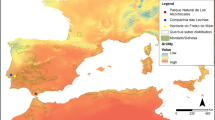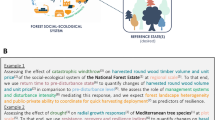Abstract
This paper addresses a large-scale problem: the degradation of protective forest plantings on arid lands in southern Russia. The degradation is primarily caused by a drastic reduction in the scope of forest-maintenance works carried out by forestry authorities due to cutbacks in funding and changes in ownership rights to lands with field-sheltering forest belts. The deterioration of forest plantings includes their pollution by domestic and industrial waste; damage caused by fire, illegal felling, diseases, and pests; the development of sod-formation processes in soils; and the thinning and decay of the forest cover. Currently, the sanitary condition of more than half of such plantings is unsatisfactory; they have reached their maximum age and have begun to decay. Due to the scale of the problem, it is suggested that the tools of the concept of land degradation neutrality (LDN) be used to monitor ongoing changes in such forest plantings and the use of accumulated practical experience to supplement the set of global LDN indicators with a number of national parameters, including the following forest taxation (valuation) characteristics: timber deposit, forest-cover percentage, and gross growth (taking into account the mortality). An additional indicator is also suggested: the biological diversity level (i.e., species diversity of the tree and shrubbery vegetation in protective forest plantings). LDN assessment should take into consideration the location of forest plantings on state-owned and private lands with various management goals.



Similar content being viewed by others
REFERENCES
Chekanyshkin, A.S. and Lepekhin, A.A., Protective forestation in Central Chernozem region, Lesn. Zh., 2015, no. 4, pp. 9–17.
Decision 7/COP.13: The future strategic framework of the Convention, The UNCCD 2018–2030 Strategic Framework. https://www.unccd.int/sites/default/files/relevant-links/2018-08/cop21add1_SF_EN.pdf. Accessed March 2, 2019.
Doklad o sostoyanii i ispol’zovanii lesov Rossiiskoi Federatsii za 2015 god (A Report on the State and Use of Forests of Russian Federation in 2015), Moscow: Rosleskhoz, 2015.
Entsiklopediya lesnogo khozyaistva (Encyclopedia of Forestry), in 2 vols., Moscow: Vseross. Nauchno-Issled. Inst. Lesovod. Mekh. Lesn. Khoz., 2006.
Federal target program “Conservation and recovery of soil fertility of agricultural lands and agrolandscapes as a national heritage of Russia in 2006–2010 and until 2030,” 2019. http://fcp.economy.gov.ru/cgi-bin/cis/fcp.cgi/Fcp/ ViewFcp/View/2013/192/. Accessed March 7, 2019.
Filed protective forest belts became ineffective: An interview with head of Administration of Krasnodarles A.I. Funtikov, Russian Agrarian Portal, 2019. https://agroportal-ziz.ru/ articles/polezashchitnye-lesnye-polosy-stali-neeffektivny. Accessed March 1, 2019.
Gauthier, S., Bernier, P., Kuuluvainen, T., Schvidenko, A.Z., and Schepaschenko, D.G., Boreal forest health and global change, Science, 2015, vol. 349, no. 6250, pp. 819–822.
Gosudarstvennyi lesnoi reestr 2013. Statisticheskii sbornik (State Forest Cadastre of 2013: Statistical Handbook), Moscow: Roslesinforg, 2014.
Kulik, K.N., Rulev, A.S., Zhdanov, Yu.M., Yuferev, V.G., Kretitnin, V.M., Isupov, B.A., Tubalov, A.A., Kosheleva, O.Yu., Dorokhina, Z.P., Koshelev, A.V., and Yuferev, M.V., Adaptivno-landshaftnoe obustroistvo zemel’ sel’skokhozyaistvennogo naznacheniya lesostepnoi, stepnoi i polupustynnoi zon evropeskoi chasti Rossiiskoi Federatsii: monografiya (Adaptive-Landscape Organization of Agricultural Lands in Forest-Steppe, Steppe, and Semidesert Zones of European Part of Russian Federation: Monograph), Volgograd, 2012.
Kust, G.S., Andreeva, O.V., and Lobkovskii, V.A., Neutral balance of land degradation as a new approach for decision making in the land use and land policy, Probl. Postsov. Prostranstva, 2018, no. 5 (4), pp. 369–389.
Lesnaya entsiklopediya (Forest Encyclopedia), Vovob’ev, G.I., Anuchin, N.A., Atrokhin, V.G., and Vinogradov, V.N., Eds., in 2 vols., Moscow: Sovetskaya Entsiklopediya, 1985.
Lesnoi kodeks Rossiiskoi Federatsii (Forest Code of Russian Federation), Moscow: Eksmo, 2017.
Martynyuk, A.A. and Erusalimskii, V.I., Input of the All-Russian Research Institute of Silviculture and Mechanization of Forestry into development of protective forestry, in VNIILM—80 let nauchnykh issledovanii (The All-Russian Research Institute of Silviculture and Mechanization of Forestry—80 Years of Scientific Studies), Pushkino: Vseross. Nauchno-Issled. Inst. Lesovod. Mekh. Lesn. Khoz., 2014, pp. 99–114.
Martynyuk, A.A. and Filipchuk, A.N., Dynamics of climate and forest: possible consequences and action plan, Aktual’nye Napravleniya Nauchn. Issled. XXI Veka: Teor. Prakt., 2017, vol. 5, no. 1 (27), pp. 276–279.
Natsional’nyi Atlas Rossii. Tom 3. Naselenie i Ekonomika (National Atlas of Russia, Vol. 3: Population and Economy), Moscow: Roskartografiya, 2009. https://нaциoнaльныйaтлac.pф. Accessed March 20, 2019.
Natsional’nyi dokald “Global’nyi klimat i pochvennyi pokrov Rossii: otsenka riskov i ekologo-ekonomicheskikh posledstvii degradatsii zemel’. Adaptivnye sisitemy i tekhnologii ratsional’nogo prirodopol’zoavniya (sel’skoe i lesnoe khozyaistvo)” (National Report “Global Climate and Soil Cover of Russia: Assessment of Risks and Ecological-Economic Consequences of Land Degradation. Adaptive Systems and Technologies of Rational Nature Management in Agriculture and Forestry”), Bedritskii, A.I., Ed., Moscow: GEOS, 2018.
On approval of The rules of afforestation, the parts of the afforestation project, and the its development procedure, Order of the Ministry of Natural Resources of Russian Federation no. 700 of December 28, 2018. http://docs.cntd.ru/document/552196662. Accessed March 15, 2019.
Ptichnikov, A.V., Karelin, D.V., Kotlyakov, V.M., Pautov, Yu.A., Borovlev, A.Yu., Kuznetsova, D.A., Zamolodchikov, D.G., and Grabovsky, V.I., Indicators in estimation of land degradation neutrality for Russian boreal forests, Dokl. Earth Sci., 2019, vol. 489, no. 1, pp. 1345–1347.
Pyatyi natsional’nyi doklad. Sokhranenie bioraznoobrazniya v Rossiiskoi Federatsii (Fifth National Report on Conservation of Biological Diversity in Russian Federation), Moscow: Inst. Geogr., Ross. Akad. Nauk, 2016.
Resolution of the Council of Ministers of the USSR and the Central Committee of the CPSU (b) of October 20, 1948 “On the planning of field protective forest belts, use of herbaceous crop rotations, pound and reservoir organization to maintain high and stable harvests in steppe and forest-steppe regions of European part of the USSR.” https://ru.wikisource.org/wiki/Постановление_Совета_ Министров_СССР_и_ЦК_ВКП(б)_от_20.10.1948_ №_3960. Accessed March 9, 2019.
Sergeeva, M., Forest belts: current state and legal principles of functions and control in Adygeya Republic, Ustoich. Lesopol’z., 2018, no. 4 (56), pp. 21–27.
Strategiya razvitiya zashchitnogo lesorazvedeniya v Rossiiskoi Federatsii na period do 2020 goda (The Strategy of Protective Forestation in Russian Federation until 2020), Kulik, K.N., Eds., Volgograd: Vseross. Nauchno-Issled. Inst. Agrolesomelior., 2008.
Web-Atlas “Environment and population health in Russia,” 2019. http://www.sci.aha.ru/. Accessed March 9, 2019.
Zamolodchikov, D.G. and Kraev, G., Impact of climate change on Russian forests: registered consequences and forecasts, Ustoich. Lesopol’z., 2016, no. 4 (48), pp. 23–32.
Funding
This article is based on a study supported by the Russian Science Foundation, grant no. 18-17-00178 (Development of the Fundamental Land Degradation Neutrality Concept to Assess the Effectiveness of Sustainable Land Use and Adaptation to Climatic Changes). The collection and primary processing of archive materials were performed as a part of the State Assignment of the Institute of Geography, Russian Academy of Sciences, state registration no. 0127-2019-0010 (Development of Scientific Bases for Sustainable Management of Natural–Anthropogenic Systems on the Basis of Balanced Land Use Models).
Author information
Authors and Affiliations
Corresponding author
Ethics declarations
Conflict of interests. The authors declare that they have no conflicts of interest.
Statement on the welfare of animals. This article does not contain any studies involving animals performed by any of the authors.
Additional information
Translated by L. Emeliyanov
Rights and permissions
About this article
Cite this article
Ptichnikov, A.V., Martynyuk, A.A. Adaptation of International Indicators of Land Degradation Neutrality for the Assessment of Forest Ecosystems in Arid Conditions in Russia. Arid Ecosyst 10, 127–134 (2020). https://doi.org/10.1134/S2079096120020109
Received:
Revised:
Accepted:
Published:
Issue Date:
DOI: https://doi.org/10.1134/S2079096120020109




